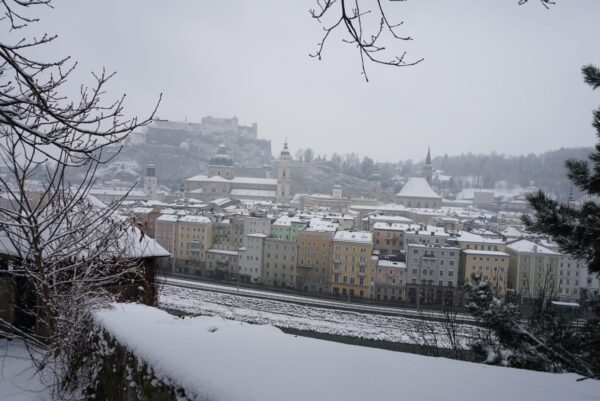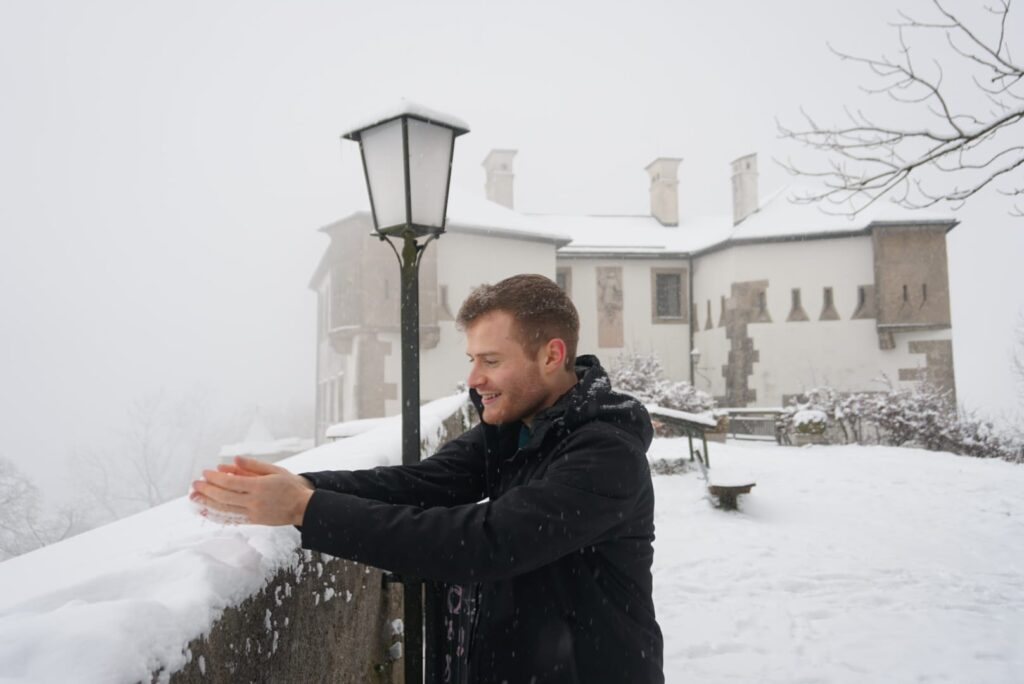The Kapuzinerberg is one of the four city mountains within Salzburg, which lies on the right bank of the Salzach river. Its dense forest around the hilltop is a popular local recreation area for city hikers and sports enthusiasts. Multiple walking paths lead past chapels to the Capuchin monastery and finally to the gorgeous Franziskischlössl. The best time for an excursion to the Kapuzinerberg is in spring. I consider this 640m high mountain as one of Salzburg’s hidden gems, quite flat at the top and covered from all sides by a rock face. Besides Mönchsberg, Untersberg, and Gaisberg, this is the perfect spot to enjoy charming views of Salzburg.
Spotting the chamois colony:
Not only do the steep walls of the Kapuzinerberg offer dreamlike views for those seeking recreation, but they are also home to a herd of goats. With a bit of luck, you will get to see them on your hike to the Kapuzinerberg. This chamois colony in the middle of the city is unique in the world and feels extremely comfortable in this rock-strewn environment. Salzburg’s city forester and hunter looks after the animals and their physical well-being.
The excursion:
When I first walked up the Kapuzienerberg, I had the choice between three different routes:
- From the northeast by the Doblerweg
- Through the Imbergstiege from Steingasse
- Via the Franziskustor
Since I live close to the Salzach river, I eventually didn’t opt for the Doblerweg, but for the Imbergstiege followed by the Stefan Zweig Trail instead. This trail is named after the famous writer Stefan Zweig, who once lived on the Kapuzinerberg from 1919 to 1934. Today, Zweig’s former property, known as the “Paschinger-Schlößl“, has found a new owner. In October 2020, the villa was sold for an incredible 8.4 million euros to Wolfgang Porsche, the head of the car brand. A bust above the villa commemorates the famous writer. Another bust, a few metres further up the hill, shows the city’s most famous genius: Wolfgang Amadeus Mozart.



The historical Steingasse:
In the Steingasse, where the trail begins, I already felt like I was travelling back in time. Supposedly, when American soldiers liberated Salzburg from Nazi rule, tanks rolled up here. One of them drove straight into the narrow Steingasse and remained stuck there. The scratch marks have ever since been left as a memorial and can still be seen today.


My trail began at the Imbergstiege, where I eventually reached the Stefan Zweig Trail. In the beginning, I climbed quite steeply up the narrow staircase. It almost seemed to me like quietly climbing the stairways to heaven, as if it was relatively rare to meet residents there.


The viewpoint at the Capuchin monastery:
The path continued past chapels up to the first plateau at the Capuchin monastery. Today, this monastery is the first joint novitiate of all German-speaking Capuchin provinces. Next to it, there is a viewpoint with a unique view of the Hohensalzburg fortress and the old town of Salzburg. Near the footpath above the Capuchin monastery, I could even view further all the way to the Geisberg mountain.


As the path continued, I noticed several chapels built in the 18th century. Moreover, there were various hiking trails and observation points as well as wide areas covered extensively by a lush park-like forest. Supposedly gazes inhabit this area, but unfortunately, I didn’t see any during my excursion.
The Franziskischlössl
At a comfortable pace, I reached the summit after about half an hour. There, I was confronted with the notorious Franziskischlössl, which houses a restaurant with a beautiful guest garden since 1849, interrupted by a few years of war. Although the Franziski-fortress has nowadays become a popular destination for excursions and refreshments, the castle was built in 1629 with the sole purpose to secure the Kapuzinerberg and the city of Salzburg as part of the defence system with its preserved fortress wall to the south and east, gun bastions to the west and carved rocks to the north.

The walls of Kapuzinerberg:
The Basteiweg trail with partly steep stairs led me from the summit of the Kapuzinerberg back to the old town directly past the well preserved fortified walls. The approximately 3 km long wall is interrupted by small lookout towers and bastions, which invited me to pause with their stunning city views. In fact, it is 400 years old, encloses the Capuchin monastery and runs around the entire western, southern and eastern slopes of the mountain. As the Basteiweg is rather steep, I can recommend taking the Stefan-Zweig-Weg back to the Steingasse for the inexperienced hikers among you. Personally, I managed to reach the Capuchin monastery after about a quarter of an hour. From there, it was only a short walk back to the Steingasse.


The Kapuzinerberg in a nutshell:
My hike up on one of Salzburg’s city mountains amazed me with beautiful panoramic views. The mountain is very easy to reach and the signposting on Kapuzinerberg is excellent and understandable even for a foreign student like me. Although I had been living in Salzburg for a while, I never wandered around this mountain properly. Now I can tell that it is definitely a place to revisit.




